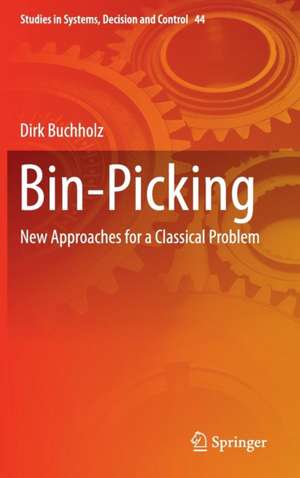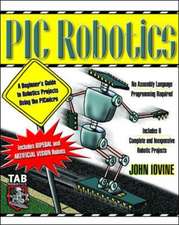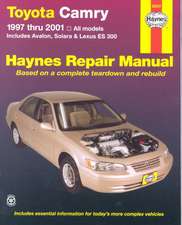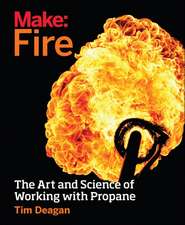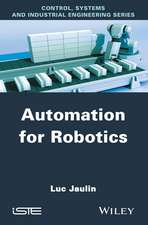Bin-Picking: New Approaches for a Classical Problem: Studies in Systems, Decision and Control, cartea 44
Autor Dirk Buchholzen Limba Engleză Hardback – 4 dec 2015
| Toate formatele și edițiile | Preț | Express |
|---|---|---|
| Paperback (1) | 637.56 lei 6-8 săpt. | |
| Springer International Publishing – 29 mar 2019 | 637.56 lei 6-8 săpt. | |
| Hardback (1) | 643.83 lei 6-8 săpt. | |
| Springer International Publishing – 4 dec 2015 | 643.83 lei 6-8 săpt. |
Din seria Studies in Systems, Decision and Control
- 18%
 Preț: 937.89 lei
Preț: 937.89 lei - 18%
 Preț: 729.53 lei
Preț: 729.53 lei - 20%
 Preț: 627.40 lei
Preț: 627.40 lei - 15%
 Preț: 644.18 lei
Preț: 644.18 lei - 18%
 Preț: 900.80 lei
Preț: 900.80 lei - 18%
 Preț: 947.35 lei
Preț: 947.35 lei - 20%
 Preț: 1467.93 lei
Preț: 1467.93 lei - 18%
 Preț: 1012.84 lei
Preț: 1012.84 lei - 15%
 Preț: 653.33 lei
Preț: 653.33 lei - 20%
 Preț: 835.23 lei
Preț: 835.23 lei - 18%
 Preț: 1112.30 lei
Preț: 1112.30 lei - 20%
 Preț: 934.24 lei
Preț: 934.24 lei - 24%
 Preț: 726.59 lei
Preț: 726.59 lei - 18%
 Preț: 1004.81 lei
Preț: 1004.81 lei - 20%
 Preț: 924.72 lei
Preț: 924.72 lei - 18%
 Preț: 1010.48 lei
Preț: 1010.48 lei - 20%
 Preț: 932.21 lei
Preț: 932.21 lei - 18%
 Preț: 1007.35 lei
Preț: 1007.35 lei - 18%
 Preț: 752.43 lei
Preț: 752.43 lei - 18%
 Preț: 1000.24 lei
Preț: 1000.24 lei - 18%
 Preț: 999.45 lei
Preț: 999.45 lei - 18%
 Preț: 1016.81 lei
Preț: 1016.81 lei - 18%
 Preț: 949.73 lei
Preț: 949.73 lei - 18%
 Preț: 1119.38 lei
Preț: 1119.38 lei - 18%
 Preț: 1412.20 lei
Preț: 1412.20 lei - 20%
 Preț: 1163.21 lei
Preț: 1163.21 lei - 18%
 Preț: 1116.26 lei
Preț: 1116.26 lei - 18%
 Preț: 783.20 lei
Preț: 783.20 lei - 18%
 Preț: 952.09 lei
Preț: 952.09 lei - 20%
 Preț: 1472.54 lei
Preț: 1472.54 lei - 18%
 Preț: 1392.46 lei
Preț: 1392.46 lei - 20%
 Preț: 1180.52 lei
Preț: 1180.52 lei - 18%
 Preț: 1567.67 lei
Preț: 1567.67 lei - 20%
 Preț: 984.18 lei
Preț: 984.18 lei - 20%
 Preț: 369.86 lei
Preț: 369.86 lei - 20%
 Preț: 1281.17 lei
Preț: 1281.17 lei - 18%
 Preț: 1582.67 lei
Preț: 1582.67 lei - 18%
 Preț: 1112.30 lei
Preț: 1112.30 lei - 20%
 Preț: 1055.94 lei
Preț: 1055.94 lei - 18%
 Preț: 1405.90 lei
Preț: 1405.90 lei - 18%
 Preț: 961.55 lei
Preț: 961.55 lei - 20%
 Preț: 1053.48 lei
Preț: 1053.48 lei - 20%
 Preț: 1049.37 lei
Preț: 1049.37 lei - 18%
 Preț: 1005.74 lei
Preț: 1005.74 lei - 18%
 Preț: 1225.94 lei
Preț: 1225.94 lei - 18%
 Preț: 1232.26 lei
Preț: 1232.26 lei - 18%
 Preț: 957.94 lei
Preț: 957.94 lei - 18%
 Preț: 890.54 lei
Preț: 890.54 lei
Preț: 643.83 lei
Preț vechi: 804.78 lei
-20% Nou
Puncte Express: 966
Preț estimativ în valută:
123.23€ • 128.16$ • 103.27£
123.23€ • 128.16$ • 103.27£
Carte tipărită la comandă
Livrare economică 14-28 martie
Preluare comenzi: 021 569.72.76
Specificații
ISBN-13: 9783319264981
ISBN-10: 3319264982
Pagini: 150
Ilustrații: XV, 117 p. 63 illus., 23 illus. in color.
Dimensiuni: 155 x 235 x 15 mm
Greutate: 0.37 kg
Ediția:1st ed. 2016
Editura: Springer International Publishing
Colecția Springer
Seria Studies in Systems, Decision and Control
Locul publicării:Cham, Switzerland
ISBN-10: 3319264982
Pagini: 150
Ilustrații: XV, 117 p. 63 illus., 23 illus. in color.
Dimensiuni: 155 x 235 x 15 mm
Greutate: 0.37 kg
Ediția:1st ed. 2016
Editura: Springer International Publishing
Colecția Springer
Seria Studies in Systems, Decision and Control
Locul publicării:Cham, Switzerland
Public țintă
ResearchCuprins
Introduction – Automation and the Need for Pose Estimation.- Bin-Picking – 5 Decades of Research.- 3D Point Cloud Based Pose Estimation.- Depth Map Based Pose Estimation.- Normal Map Based Pose Estimation.- Summary and Conclusion.
Textul de pe ultima copertă
This bookis devoted to one of the most famous examples of automation handling tasks –the “bin-picking” problem. To pick up objects, scrambled in a box is aneasy task for humans, but its automation is very complex. In this book threedifferent approaches to solve the bin-picking problem are described, showinghow modern sensors can be used for efficient bin-picking as well as how classicsensor concepts can be applied for novel bin-picking techniques. 3D pointclouds are firstly used as basis, employing the known Random Sample Matchingalgorithm paired with a very efficient depth map based collision avoidancemechanism resulting in a very robust bin-picking approach. Reducing thecomplexity of the sensor data, all computations are then done on depth maps.This allows the use of 2D image analysis techniques to fulfill the tasks andresults in real time data analysis. Combined with force/torque and accelerationsensors, a near time optimal bin-picking system emerges. Lastly, surfacenormalmaps are employed as a basis for pose estimation. In contrast to knownapproaches, the normal maps are not used for 3D data computation but directlyfor the object localization problem, enabling the application of a new class ofsensors for bin-picking.
Caracteristici
Presents three full approaches to solve the bin-picking problem: based on normal maps, using depth maps, and based on point clouds in combination with depth maps Explains the three approaches in detail and in connection to each other, while individual chapters are also understandable on their own Serves as introduction to bin-picking and pose estimation Includes supplementary material: sn.pub/extras
